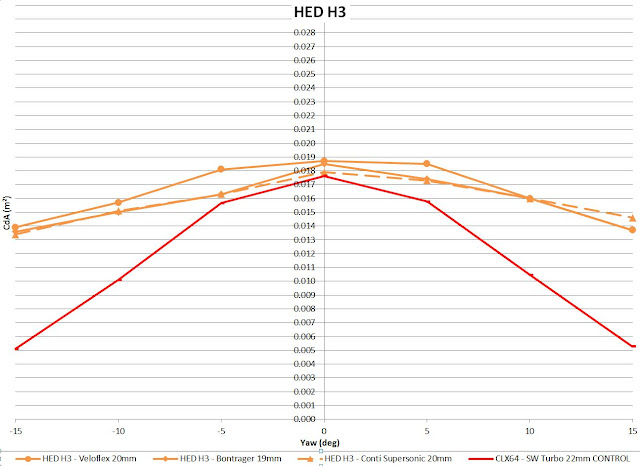In the previous blog post (Win Tunnel Playtime - Part 1), I described how this particular adventure came about, and I presented the bulk of the data collected, which was the result of a large amount of wheel and tire testing. In this post, I'll be covering the remaining testing we did on that day. In short, we did a small number of bike-only runs, varying the front wheel on the bike. This was done in an attempt to see how the differences in drag compared to the wheel-only runs for changes in front wheels. Most of the testing was done using my personal bike (a Stinner Frameworks custom steel road frame), and for comparison sake, we also tested a brand new Specialized Venge ViAS which just happened to be available <smirk>.
So...let's get to it. Shown below is a summary plot of all of the bike-only runs. As a bit of explanation, the combinations tested were as follows:
- Stinner with Hed Jet6+ wheels and 24C Specialized Turbo Cottons. Specialized Virtue bottle. This setup represents my own personal rig, set up in what I like to call "crit mode".
- Same as #1, with front wheel swapped for a Roval CLX64 with a 22C Specialized S-Works Turbo tire.
- Same as #1, but with front wheel swapped for Flo 90 with 23C Continental Super Sonic tire.
- Same as #3, but with round bottle and bottle cage swapped over from Venge ViAS frame on downtube (low location).
- Venge ViAS with Roval CLX64 wheels, 22C Specialized S-Works Turbo front, 24C rear. Round bottle on downtube.
Aside from how impressively low the drag is for the Venge ViAS in that chart above, what is particularly interesting is how those 3 upper plots (with the same bottles on the bike) compare to each other, AND to the wheel-only data. To do that comparison, I looked at the differences seen between those particular combinations of wheels and tires during the wheel-only testing and compared them to the bike testing. Those comparisons are summarized in the following 3 charts.
What we can see from the above is that in most cases the differences in drag observed from wheel only data are within 0-.002 m^2 of the differences observed when those same wheels are swapped for the front wheel in a bike. There are a couple of differences that vary by .003m^2 in that data, but overall I'd have to say that the "predictive" utility of how a front wheel will perform within a bike based on wheel only data is pretty good.
Now we get to the part where we put a "floppy human" (me!) on board and see what happens. Due to time constraints, for this portion of the data gathering we only took 2 yaw data points (0 and 10 degrees), which each consisted of 60s of sampled data. Since the Venge ViAS was there (and in my size!) of course I made sure to get a set of runs in on that. Since the Venge was the last bike from the bike-only runs and was already mounted to the tunnel balance platform, that was the first up.
Next was the Stinner with the Hed Jet6+ and Turbo Cotton tires (in my "crit setup")
And finally, we swapped the front wheel for the Roval CLX64 and 22C S-Works Turbo.
Here's how that all played out:
As you can see, the difference at zero yaw between the Roval wheel and the Jet 6+ (as configured) was ~.003 m^2, which compares pretty favorably with the ~.002-.003 m^2 observed in the wheel-only and the bike-only testing for those combinations.
At 10 degrees of yaw, the difference appears to be somewhat larger, with the bike-with-rider testing showing a difference of ~.012 m^2 whereas the bike and wheel-only testing was more like .006-.007 m^2 of difference observed.
What's truly interesting though, is how closely the overall drag was brought together between the Stinner and the Venge ViAS when a rider is on board. At zero and 10 degrees of yaw, the drag difference appears to be less than half of what was observed in the bike-only testing. This puts my overall drag when on the Stinner to within .004-.006 m^2 of what it was on the Venge ViAS at zero and 10 degrees of yaw. Obviously, there must be something going on with bike interactions near the rider. Also, it's important to point out that the comparison between the bikes wasn't completely "apples to apples" since the water bottles were different. However, the Venge ViAS is designed to be basically "bottle neutral", so that's not too big of a factor. Another difference was that the bars were not identical, neither in model or in width. But again, the bars on the Stinner, although slightly narrower (40 vs. 42 for the Specialized bar) also have drops which are deeper...so, that probably ends up being a "wash" in the bike-only testing.
So...another large dump of data...with a few good conclusions. It appears that when making changes to the "leading edges" of the bike equipment (such as wheels, forks, bars, etc) drag differences observed in component-only and bike-only testing "hold" when applied to testing with a rider on board, at least for near zero yaw. However, that probably can't be said for pieces of the puzzle that are further back in the flow and interact more closely with one another.
As always, if you have any questions, just fire away in the comments...oh, and the data for this portion of the testing is found here: Bike and Rider data




















